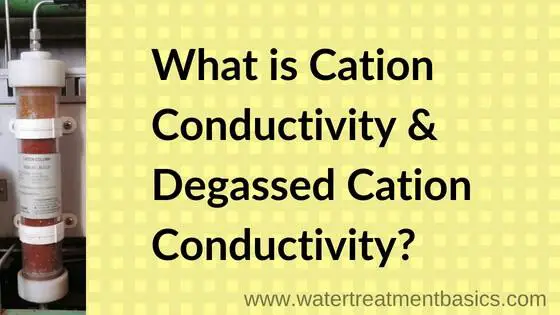What is Cation Conductivity?
This term is generally applicable in boiler water treatment. The concept is same as Strong Acid Cation(SAC) column works in DM Plant. To measure cation conductivity water sample is passing through cation column filled with cation resin in the hydrogen (H+) form. It is also known as acid conductivity.
Why It is Important:
Cation resin removes positively charged ions (cations) & replaces with H+ ions. In a high purity water cation present in ppb levels very small amount. For instance,If NaCl is present in this case when we passing sample through cation column Na+ ion is removed & Cl– ion react with H+ ion produces HCl (hydrochloric acid) that have a higher conductivity.
Please keep in mind that particular cation or anion is separately not present in water. Always they are present in combination with each other. e.g. NaCl,MgCl2 etc.
As name suggest it is a measurement of the conductivity after removing cations from water sample. it is indirect measurement of anions present in water, mainly chloride & sulphate present in steam samples.
In other words cation conductivity magnifies the anion present in water & indicates steam purity. Most steam turbine manufacturer recommends cation conductivity limit of <0.3 µs/cm.
High conductivity observed in water sample due to below points:
- Exhausted cation column
- Overfeed of amine & oxygen scavenger chemicals
- Total organic carbon or organic decomposition products(acetate, formate) present in high level
- High level of anion contamination present in water.
In practice, well controlled & maintained feed water chemistry can consistently maintain cation conductivity below 0.5 µs/cm when using organic amine and organic oxygen scavenger.
Degassed Cation Conductivity:
The degassed cation conductivity measurement uses the same ion exchange strategy as the cation conductivity measurement. The degassed measurement incorporates a reboiler to remove volatile compounds (like ammonia, amine, volatile organics, and CO2) from the steam to provide a more accurate indication of sulfate and chloride levels.
In the degassed measurement, the sample passes through a reboiler. Volatile organic compounds and CO2 are vented to atmosphere. Non-volatile inorganic compounds (like sulfate and chloride) remain behind. Thus, the degassed cation conductivity measurement provides the most accurate indication of inorganic anion levels (salts) in the steam.
Most steam turbine manufacturers recommend cation conductivity limits of 0.2-0.3 uS/cm. As stated earlier, the steam turbine manufacturer limits are not realistic unless ammonia and hydrazine are the only products used for feedwater treatment. In practice, well-controlled feedwater chemistry can consistently maintain cation conductivities in the 0.4-0.8 uS/cm range when using organic amine or organic passivators.
